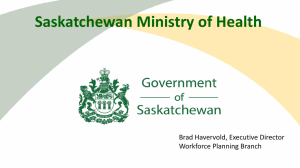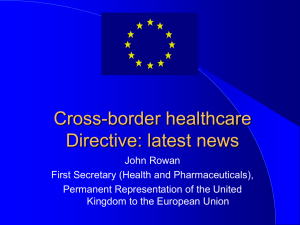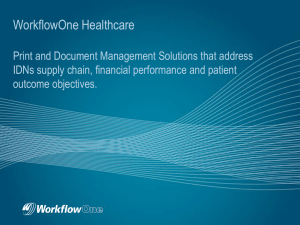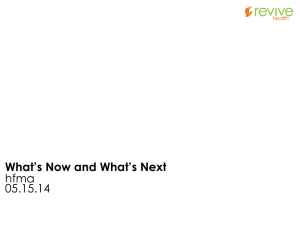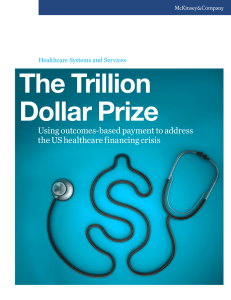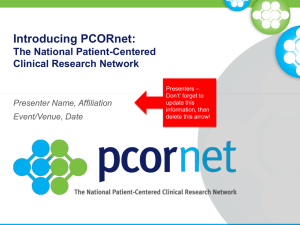Abby Sears - Institute of Medicine
advertisement
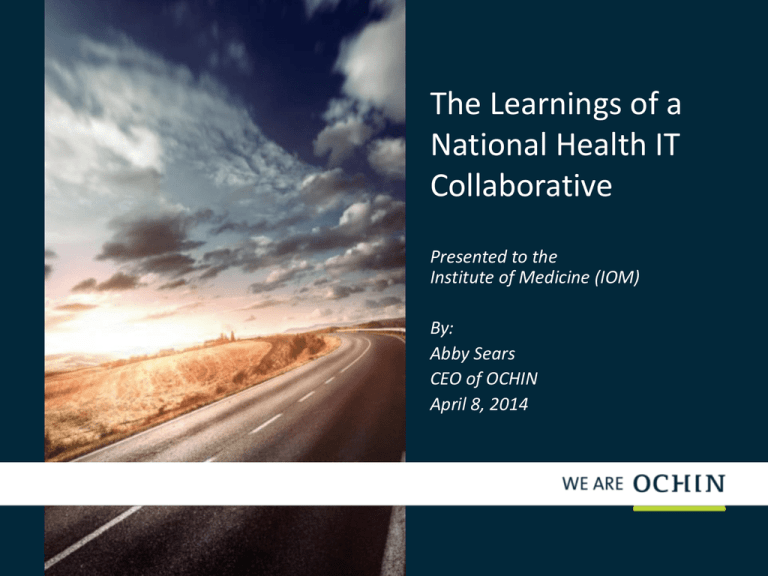
The Learnings of a National Health IT Collaborative Presented to the Institute of Medicine (IOM) By: Abby Sears CEO of OCHIN April 8, 2014 Who is OCHIN? Who is OCHIN? • As a nonprofit organization, healthcare innovation organization designed to promote access to quality, affordable healthcare for all. • One of the nation’s largest and most successful Health Information Networks In 18 states, coast-to-coast Touching over 4,500 physicians Who We Serve • Any member of the healthcare continuum requires equal access to the next generation of integrated healthcare delivery • We have a history in underserved populations, Federally Qualified Health Centers, Mental/Behavioral Health, Public Health Agencies, Rural Health Clinics, and Critical Access Hospitals What We Do: Breadth and Depth What Makes Us Different? The Community as a Learning System State Public Health Community Organizations Community Practice Federal Agencies Community Members COMMUNITY FOCUSED: Governance Engagement Standards & Trust Analysis Dissemination Integrated Delivery System Health Information Organization 8 Academic, Foundation, and Data Partners The Community as a Learning System; The National Committee on Vital and Health Statistics, 2011 Member Engagement Along the Adoption Curve Barriers and Opportunities to New Technologies: Clinical Practice changes via technology The obstacles are numerous and are challenging to resolve • Data and Privacy policies need updating • Healthcare is highly regulated environment • Varied business requirements of different clinical domains and requires time and commitment to capturing the data • Payors and Federal agencies have different data needs and requests • Challenges of small practices with little to no IT support • Economic issues of running small practices • Change Fatigue – so many environmental demands at one time Changes Are Necessary: Policy and More • Rules at the federal and state level: New rules for technologically sharing data for integration of behavioral and mental health and more – – – – Alcohol and drug data is protected from other clinicians Family Planning data Sharing of immunization data across state lines Different narcotic prescription rules by state • Increased support in the field – Especially for small practices, clinics with 1-10 providers • Lack of sophistication, staff, funds, interest – They want the help, but have neither the infrastructure, nor the financial support, to get it – “what is useful” functionality continues to be unclear – Larger practices do this in-house Off the Shelf Products: What can you do with them? • Adding Technology to “Canned” Solutions – Focus is on meeting regulatory requirements: PQRS, HEDIS, Meaningful Use and privacy concerns – Social determinants of health – HIE – Provider Directory issues – Major pieces of the software products still are working out the basics – Is it standard programming or customer…how does this impact future upgrades Change requires a three pronged approach Technology Change Training/Documentation Data and reporting on utilization Needs to be in the workflow and lots of reinforcement and training – Alternative Payment methodologies – technology has been deployed but the workflows haven’t changed – Building more functionality than the physicians can accommodate – It takes time to reinforce new behaviors – Constant reinforcement by the environment with continuous education and support – Teach at every level in the clinic Follow the money: Payors and Price • Payors are differentiating themselves on quality and cost – Need to pay for quality in a slow and incremental way that doesn’t hurt the providers but continues to encourage slow, gradual change – Pilot small projects that will look at new ways to pay for quality across the spectrum of providers – ask them to fund projects that bridge organizations – Look for reward programs • Be willing to consider taking on some risk especially in small amounts – Look at PACE program of high risk Medicaid and Medicare patients for good opportunities • Encourage the payors to agree on definitions of quality at the community or better yet at the state level – Ask to show improvement not an outcome or a target – How to use data to impact positive change needs to be part of all education requirements at Medical Schools Sharing and Celebrating the Achievers • Peer to Peer knowledge sharing creates high leverage learning opportunities especially on a shared system Sharing knowledge between practices and clinicians – Most clinicians want to have provide excellent quality – More focus at the medical associations – Send comparison data in non-threatening and learning environments to discuss why and what can change • Look at the continuing education system for opportunities advanced knowledge Sharing technology knowledge: Why can’t I email or copy it? • Flexible vs non-flexible systems: – Flexible typically means the product is highly configurable which has a direct correlation to cost; manual staff resources to build and maintain – Lower cost systems tend to allow less customizability – Are we on different versions? – Did we buy the same hardware? – Are we in the same state? Are the regulations the same? – IP confidentiality and non-disclosure issues Breaking Barriers: Innovation and Partnership • There is no one answer, but there is an approach – build change packages • Innovation at the clinic level – starts with physicians • You need to invest, but you can’t do it alone • Partnering with groups to build • Look for shared learning opportunities help each other – Peer groups • Capitalize on continuing education process • Use Associations to support new legislation • You get what you pay for in Health IT because of regulation requirements • Requires a high touch approach Success Stories • IPAs, safety net clinics, Regional Extension Center and Hospital Deployments to perform group purchasing and support • Advocacy to improve legislation and policy to build; potential new legislation around CFR-42 • More education programs to support more workforce • Build an ongoing support mechanism for • HIT investments by Foundations for social venture capital in products to help embedded change Thank You OCHIN Inc. @OCHINinc Abby Sears CEO of OCHIN searsa@ochin.org


